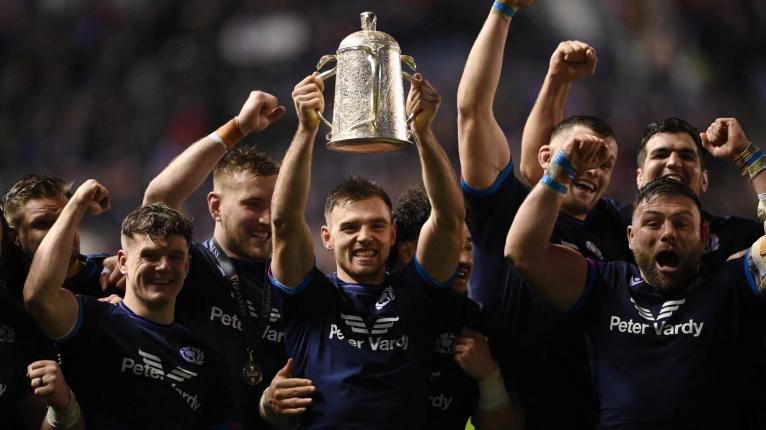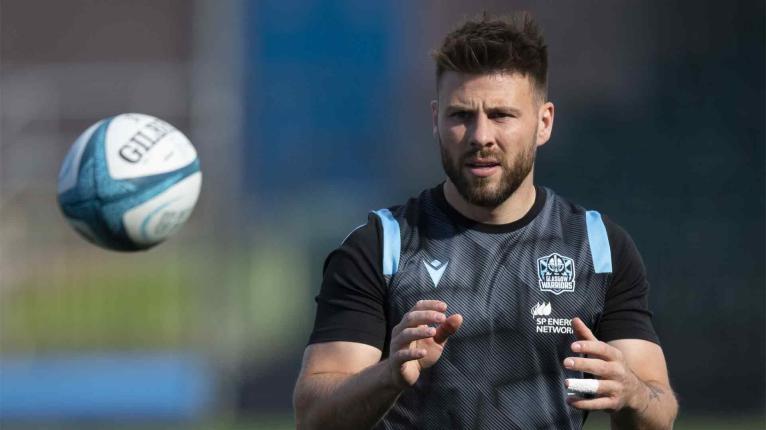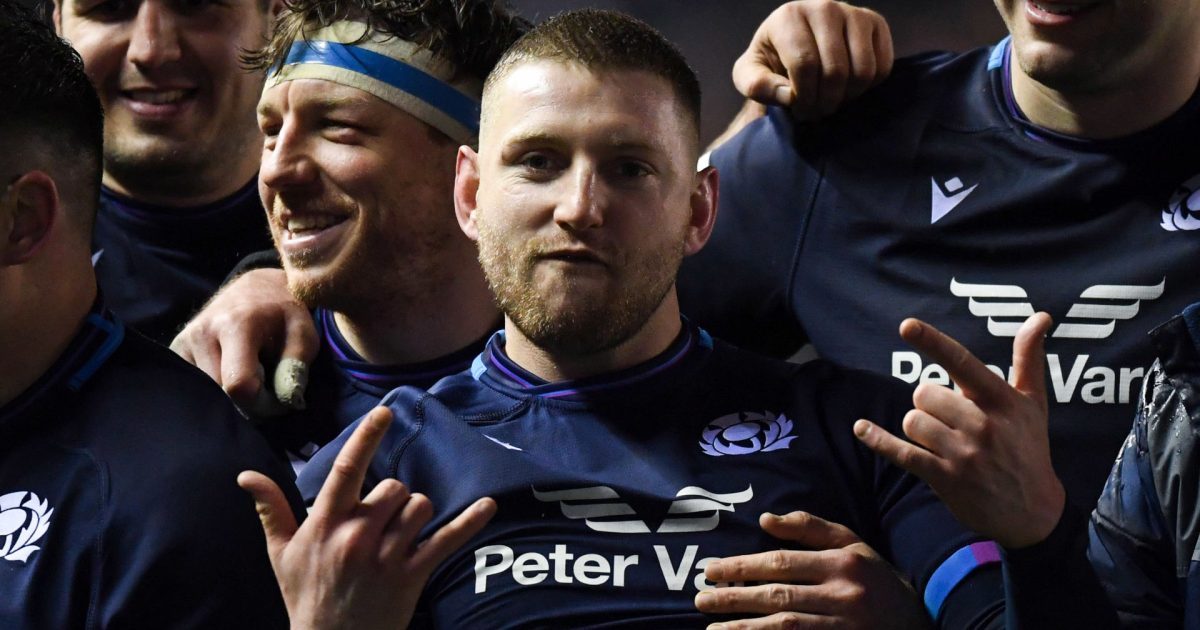Scotland will beat England or die trying

Scotland have never approached the home of English rugby with anything less than a full-throated roar, but this year, Gregor Townsend is not so much parking his tanks on the Twickenham lawn as throwing in a few bazookas, launching a squadron of Typhoons overhead and sending an aircraft carrier up the Thames for good measure. He has picked his most aggressive, most attacking team possible to storm the ramparts and sack the fortress.
In years gone by, there was a sense of trepidation about Twickenham. Scots were haunted by the ghouls of the past, the decades of torment and misery and at times, ridicule. Those ghosts are banished now. Victory in 2021 ended almost forty fruitless years of traipsing down to London and traipsing home again defeated.
An awful lot went right that day. Scotland’s set-piece fired in a compelling way. They brought brutality and steel to England’s back yard. Duhan van der Merwe did his rogue buffalo act. Cam Redpath sparkled on his first cap. Scotland were accurate and accomplished in almost everything they did. And there were no baying Twickenham punters, fans instead confined to barracks in the throes of the pandemic. Scotland won, and deservedly so, but English detractors can always point to the empty stands and the eerie silence and ask whether they could do it before 82,000.
There is a spice to the fixture, particularly now. The almighty horsing inflicted by England in 2017 rankled deeply with many on the opposite side. Scotland took their Murrayfield revenge a year later with Ryan Wilson making mischief in the tunnel. The unbridled mayhem of 2019 and the 38-38 draw. Angst-ridden away wins in 2020 and 2021. Luke Cowan-Dickie’s penalty-try slap in 2022 and Scotland’s grim defiance as their scrum teetered.

It has been levelled at England that their Celtic brethren cared more, were more aggressive, more motivated when these fixtures rolled around. If that ever was the case, and every English player would bristle at the notion, it certainly isn’t now. England have laid paws on the Calcutta Cup once in five years. Their towering home record has gone up in smoke. They should have obliterated Scotland in 2019 and should have won at Murrayfield in 2022. They are a bigger and richer rugby nation by any measure. Speaking recently on Jim Hamilton’s ‘Big Jim Show’, when asked which team he wanted to beat more than any other, Billy Vunipola replied: ‘Scotland’.
Don’t be fooled into thinking the visitors are favourites here. It is hard to envisage a scenario in which a Scottish team trots out at Twickenham as anything but underdogs. England have so many options and so much depth.
What will they bring under new management? Steve Borthwick has had scant time to mould his players. His first mission will be to restore clarity to a group that looked confused and uncertain in the last days of Eddie Jones. Marcus Smith and Owen Farrell, two terrific operators with contrasting skillsets, have been tossed together in an uneasy play-making alliance. Though injuries have forced Borthwick’s hand to some degree, the hope is they mesh more harmoniously with his new, detailed approach. Fascinating, too, how they utilise the pace of Joe Marchant, instead of the beef of Manu Tuilagi.
Borthwick will look to solidify England’s traditional strengths: their forward brawn, their set-piece and their smart kicking game. He can rely on Ben Curry and Lewis Ludlam and Ellis Genge to bring that snarl. Kevin Sinfield will instil a more aggressive defensive system, no question. With only two weeks of preparation, every second on the training paddock is crucial.
The clock is ticking on Scotland in a different way. Barring an unlikely turn of events, this will be Gregor Townsend’s last Six Nations, and his last chance to achieve something tangible in a championship. Townsend has changed the Scottish narrative and shifted the dial of expectation, splintered hoodoos in Wales, France and England and overseen some fabulous individual results, but his teams have never gone into the final round of a Six Nations in the hunt for the title. Consistency eludes them.
This, while he has cultivated, and had access to, the finest generation of Scottish talent in two decades. The men before him never had this tier of cattle. They never had a Stuart Hogg or Finn Russell in their prime years, the glut of midfield and back-row riches now on offer to Townsend, the pedigree of pack or the prowess of wingers. Hogg and Russell are 30 now. Many of the key Scottish protagonists are at their peak and if they are going to mount any kind of credible challenge, it will have to happen soon. With a World Cup looming, and his contract expiring, the months ahead will define Townsend’s legacy.

The stakes demand bold selections and Townsend has made some whoppers. Across the board, he has backed form over reputation and left a heap of experience on the sidelines. He has done without Ali Price, his go-to man in the scrum-half berth since 2019. Hamish Watson has played only once for Edinburgh since returning from injury and doesn’t make the 23. Rory Sutherland has struggled for fitness and is out too. Sean Maitland is not selected. Chris Harris is benched. When you throw in Zander Fagerson, not fully recovered from a hamstring problem, that’s six Lions out of the starting XV.
Price is the most ballsy omission. Since Greig Laidlaw retired after the 2019 World Cup, Scotland have played 30 Test matches and Price has started 28 of them, becoming a Test Lion along the way. According to statistician Kevin Millar, Laidlaw and Price have shared the jersey in all but two of the 50 Six Nations games from 2013 to now. Price is a vital cog in the Scottish machine but in dropping him, Townsend is sending a clear message: the man in form will play.
And if we’re looking purely at form, it is hard to make a case for Price. Ben White has excelled for London Irish with Nick Phipps departing over summer. Price emerged as an exciting, fast-breaking nine but in recent seasons has played more conservatively, sniping less often. His last Test try came against Georgia in a 2019 World Cup warm-up. White offers more threat around the fringes and Townsend has been keen to trumpet his improved kicking game. On the bench, George Horne is the perfect zesty substitute, a man who has revelled in Franco Smith’s transformation of Glasgow and kept Price out of the team virtually all season.
In the back-row, Watson has not made the kind of irrepressible impact we’ve come to expect this term. Injury has robbed him of momentum and the chance to build up his game again. In his stead, Luke Crosbie has come of age, finally given the chance to underline his burgeoning credentials. Crosbie won his first cap against Tonga in November 2021, his second in the opening Argentina Test in July. He has been on the periphery for an age and now his opportunity beckons.
The flanker has earned it, too. Not just in his youth in West Lothian, outfighting and outworking his private school rivals, but in the past year with Edinburgh. He has been one of Mike Blair’s most consistent and most effective performers. The Champions Cup duels with Saracens were his statement showings. At the StoneX, he bossed the breakdown. At the DAM, he was wonderfully, confrontationally aggressive. He took it to the international-laden Saracens pack again and again. Townsend took note of that. Crosbie is, emphatically, ready for Twickenham.
Pierre Schoeman was a colossus when Saracens were put away in the Scottish capital. The loose-head made over 20 carries and played 80 minutes. More will be demanded from him, particularly in Sutherland’s absence.
WP Nel was a huge contributor that day, too. With Fagerson out, tight-head is a gnawing concern. So much now rests on Nel’s squat, ageing shoulders. Shoulders that still show little sign of creaking. Nel lasted the whole Saracens game and won a scrum penalty with the clock red. He has experienced more scrums than a Sauchiehall Street bouncer and vanquished more opponents than He-Man but at nearly 37, this may be the old bull’s greatest challenge in a Scotland jersey.
Out wide, the calls are tantalising. Sione Tuipulotu is the form player in Scotland. A cheat code for Glasgow, with his carrying power melded to a dexterous footballing brain. He has pried open defences with cute little grubbers, and ploughed through them with raw dynamism. His distribution is excellent.
For this game, it was always Tuipulotu plus who. Townsend has plumped for Tuipulotu plus Huw, or Huwipulotu as the pulse-quickening centre pairing has been christened at Scotstoun. The two of them savaged the champion Stormers defence last month.
Jones has rediscovered himself as a midfield rapier. He endured a particularly harrowing Twickenham day in 2017 when he was filleted over and over by a rampant English backline, but people can no longer use his defence as a stick with which to beat him. Jones has made sure of that. And yet, he last played, and started, a Test in March 2021. It’s another massive decision. Harris has long been a Townsend favourite at 13. The Gloucester man has so much credit in the bank, but not enough to start. Jones’ scintillating attack is preferred to Harris’ iron defence. It’s a recurring theme.
Townsend has talked up Kyle Steyn, the new Glasgow captain, on the right wing. Darcy Graham is a grievous loss but Steyn is a hefty, explosive customer with and without the ball. That he starts ahead of Maitland, assured and classy and defensively impeccable, shows how hard he has pressed his case.
These are all calculated gambles, and there are more besides. Van der Merwe has not played since hirpling off in the 1872 Cup decider on 30th December. He was back in South Africa last month to get married. Hogg last featured for Exeter on Christmas Eve owing to a niggly heel. Scotland must have both men motoring come Saturday.
Rugby folk across the nation pray that the mended fences between Townsend and Russell hold. Russell is leaner, sharper, and perhaps hungrier than ever in a Scotland jersey. Both men need each other. Scotland need Russell to fire all tournament. He’s that important.
On the whole, it’s an exhilarating line-up. Townsend has made it clear he is picking players for the now, not projects for the years ahead. The time for development and experimentation is over. No pandering to the past. No fretting over the future. No chance of dying wondering. Such threat, such panache and such potency across the backline. Ammunition galore, all guns blazing. Jones over Harris. Steyn over Maitland. White over Price.
This is a team carved in Townsend’s image. A team picked on form. A team on which the coach will stake his last tilt at the Six Nations.

































Nel, Schoeman, Fagerson, Tuipolutu, Steyn, Huwipulotu. Are there any actual Scotsmen in the team?
Wow! I'm sold. This will be a cracker of a test if this teaser is anywhere near accurate.
I was breathless by the end of this. Superb. SCOOOOOOTLAAAAAAND!